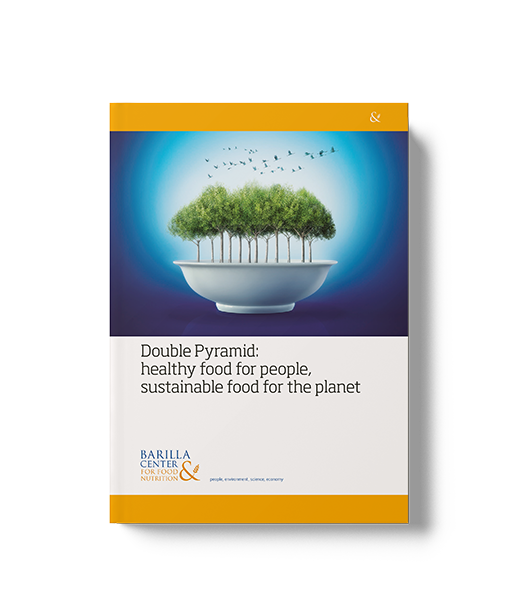
Barilla Center for Food & Nutrition
Double Pyramid: healty food for people, sustainable food for planet
Barilla Center for Food & Nutrition
Scaricato 250 volte
We know well that healthy living requires proper nutrition. To explain how to adopt this kind of balanced diet, in 1992 the U.S. Department of Agriculture developed and promoted the "Food Pyramid."
Today, the Barilla Center for Food & Nutrition, through the Double Pyramid model, explores a new approach in which foods are positioned according to their impact on both health and the environment.
This results in a new “doubled” pyramid — both nutritional and environmental — which clearly shows that the foods recommended for more frequent consumption are also those with the lowest environmental impact. Conversely, the foods recommended for limited consumption tend to have the greatest environmental impact.
This new elaboration of the food pyramid reveals the convergence, within a single model, of two different yet equally important goals: health and environmental protection.
The Barilla Center for Food & Nutrition
Executive summary
1. Eating better for a better world
1.1 The Food Pyramid as an educational tool
1.2 Components of the Food Pyramid
1.3 From the Food Pyramid to the Environmental Pyramid
2. Scientific basis of the Food Pyramid
2.1 Studies involving the Mediterranean Diet
3. Indicators used to measure environmental impact
3.1 Carbon Footprint
3.2 Water Footprint
3.3 Ecological Footprint
4. Measuring the impact of foods: the three environmental pyramids
4.1 Summary of environmental data
4.2 Three possible Environmental Pyramids
4.3 The Environmental pyramid based on the Ecological Footprint
5. Details of environmental data gathered
5.1 Main data sources
5.2 Assumptions utilized for the cooking of foods
5.3 When the impact of transport is relevant
6. AREAS FOR FURTHER INVESTIGATION IN THE SUBSEQUENT EDITION
6.1 Broaden the statistical coverage of data and render LCA boundaries homogeneous
6.2 Take into consideration geographical origin in evaluating impact
6.3 Evaluating the influence of food refrigeration and completing analysis of cooking methods
6.4 Studying the question of the seasonal nature of agricultural products as a variable influencing impact
Bibliography by food product
Foods derived from agriculture
Foods derived from processing of agricultural products Foods derived from animal husbandry
Foods from fishing
Beverages
Appendix
A.1 Calculation of the environmental impact associated with the production of baked goods
Bibliography
Il Barilla Center for Food & Nutrition (BCFN) è un think tank multidisciplinare fondato nel 2009 all’interno della Fondazione Barilla e trasformato in fondazione autonoma nel 2014, con l’obiettivo di raccogliere e analizzare conoscenze sulla filiera alimentare per proporre soluzioni sostenibili e salutari. Con sede a Parma e finanziato dal Gruppo Barilla, riunisce esperti in nutrizione, economia, scienze ambientali e sociologia per studiare le dinamiche di produzione, consumo e spreco alimentare.
Organizza eventi internazionali, tra cui il BCFN Forum, workshop e webinar, coinvolgendo istituzioni, università e ONG in partnership strategiche. Offre programmi di formazione e comunicazione, webinar e risorse online per sensibilizzare consumatori e operatori del settore sulle sfide nutrizionali e ambientali. Grazie a collaborazioni con FAO, IFAD e altre agenzie internazionali, il BCFN contribuisce a definire linee guida e policy per una dieta sana, equa e rispettosa del pianeta.
